



small RNA group Mainz
The small RNA group is embedded in the Institute of Organismic and Molecular Evolution at the Johannes
Gutenberg University. Our work intends to provide insights into function and evolution of small
RNA pathways in diverse animal species including human and non-human primates and model
systems such as mouse and drosophila, with the emphasis being on the fast evolving Piwi/piRNA system.
We concentrate on comparative analyses of small RNA transcriptomes and the development of new bioinformatic tools such as unitas, a universal tool for convenient annotation of small RNAs, or the piRNA cluster prediction software proTRAC that allow us to reveal functional and evolutionary coherences based on high-throughput sequencing data. We closely collaborate with the Institute of Molecular Biology (IMB), particularly with the group of René Ketting (Biology of non-coding RNA) but also with other groups from Europe, Canada, China and the USA. We participate in the IMBs International PhD Program (IPP), International Summer School (ISS) and are part of the research focus GeneRED (Gene Regulation in Evolution and Development).
Follow us on Twitter
Follow @smallRNA_Mainz
We concentrate on comparative analyses of small RNA transcriptomes and the development of new bioinformatic tools such as unitas, a universal tool for convenient annotation of small RNAs, or the piRNA cluster prediction software proTRAC that allow us to reveal functional and evolutionary coherences based on high-throughput sequencing data. We closely collaborate with the Institute of Molecular Biology (IMB), particularly with the group of René Ketting (Biology of non-coding RNA) but also with other groups from Europe, Canada, China and the USA. We participate in the IMBs International PhD Program (IPP), International Summer School (ISS) and are part of the research focus GeneRED (Gene Regulation in Evolution and Development).
Follow us on Twitter
Follow @smallRNA_Mainz
NEWS
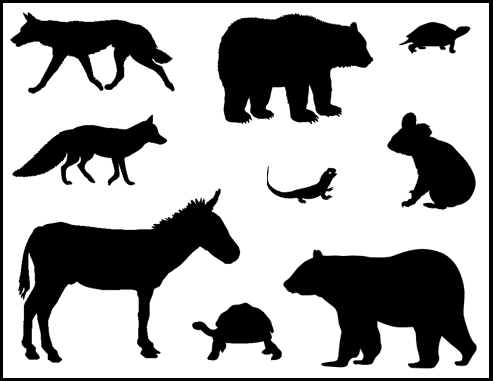 25/01/2019
25/01/2019Together with the new Ensembl release we provide an updated version (1.6.2) of unitas which is available for download here. Among others, donkey, polar bear, black bear, red fox, koala, dingo, tuatara, painted turtle and desert tortoise now join the list of 1281 supported species. No more reasons to back away from studying small RNAs in your favorite species!
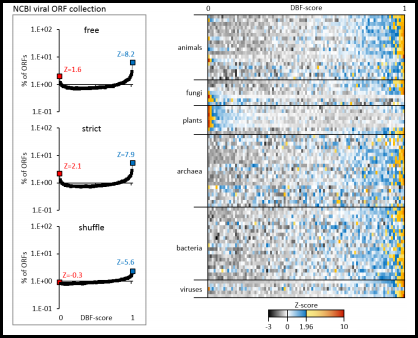 22/01/2019
22/01/2019Check out our latest pre-print entitled "Widespread selection for high and low secondary structure in coding sequences across all domains of life". Any comments are welcome!
 15/10/2018
15/10/2018An updated version (1.6.1) of unitas is available for download here. It uses the latest releases from Ensembl (94) Ensembl Genomes (41) miRBase (22) and SILVA (132). The tiger tail seahorse (Hippocampus comes) joins the list of 1229 supported species, more rRNA, more tRFs, more miRNAs...
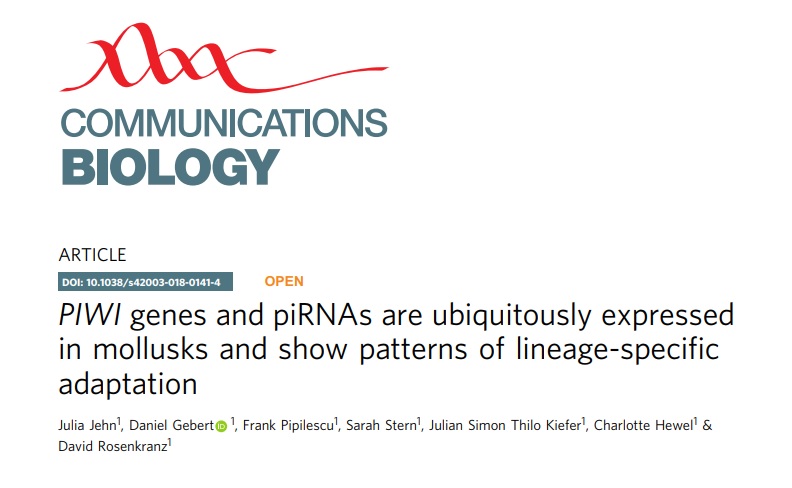 07/09/2018
07/09/2018Our new paper on PIWI genes and piRNAs in mollusks is now available at Communications Biology. "PIWI genes and piRNAs are ubiquitously expressed in mollusks and show patterns of lineage-specific adaptation". Check it out here.
 20/04/2018
20/04/2018An updated version (1.5.2) of unitas is available for download here. It uses the latest releases from Ensembl (92) Ensembl Genomes (32) miRBase (22) and SILVA (132). That means 1193 supported species, more rRNA, more tRFs, more miRNAs...
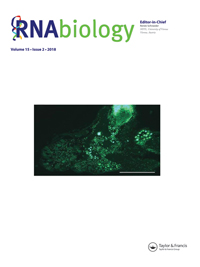 07/02/2018
07/02/2018Check out our new paper in RNA Biology, a solicited point-of-view: Isabel Fast & David Rosenkranz (2018) Temperature-dependent small RNA expression in Drosophila melanogaster, RNA Biology, DOI: 10.1080/15476286.2018.1429881. A limited number of free reprints is available here.
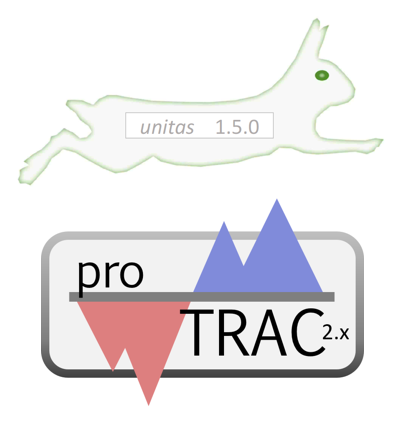 22/12/2017
22/12/2017Updated version of proTRAC (2.4.0) and unitas (1.5.0) are available for download. proTRAC now calculates the amount of repetitive DNA for each cluster separately and all clusters together, compared to the genomic amount of repetitive DNA. unitas now includes updated internal web links according to the new Ensembl release 91 and SILVA release 132. We further added some piRNA ping pong analysis steps and fixed minor bugs.
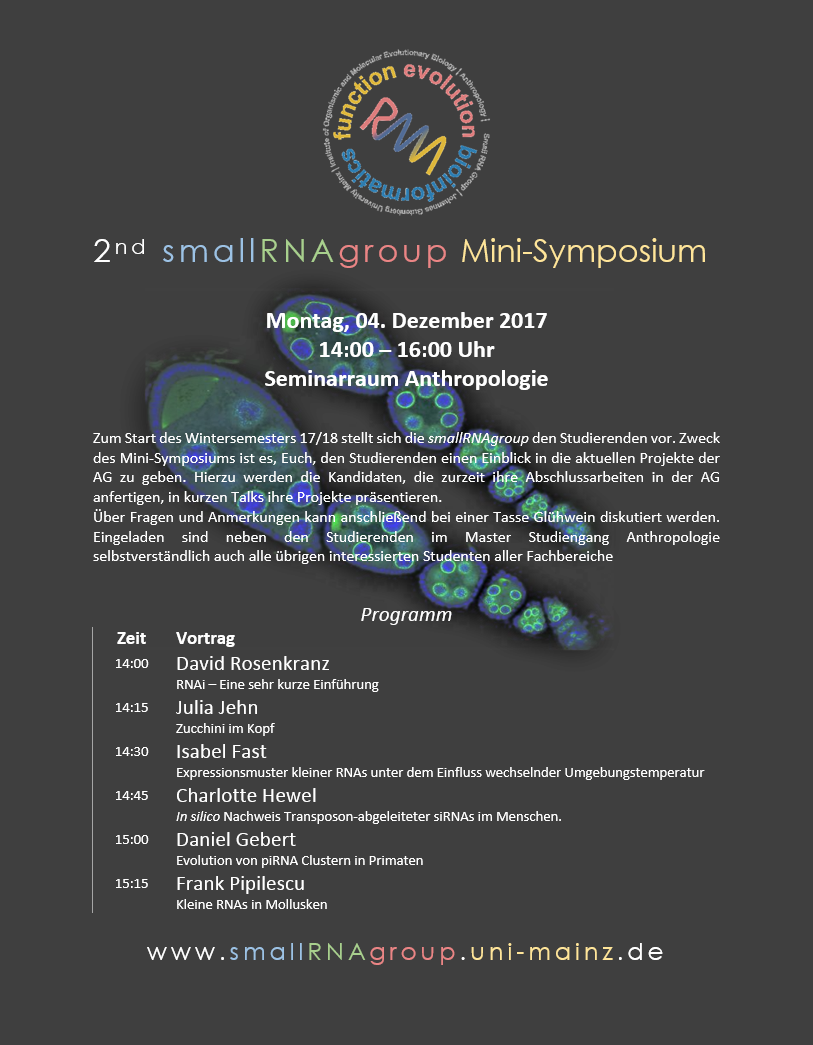 25/10/2017
25/10/2017Announcement: The 2nd smallRNAgroup Mini-Symposium will take place on Monday, 4th December in the Seminarraum Anthropologie. Candidates of the group will present their projects in short talks. Following this: Discussion and Glühwein. Anyone interested is welcome to attend!
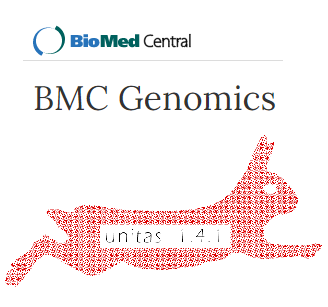 22/08/2017
22/08/2017New paper puplished in BMC Genomics: unitas: the universal tool for annotation of small RNAs. You can download and try the latest unitas version here.
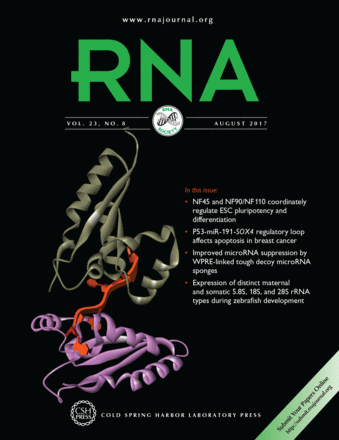 19/06/2017
19/06/2017New paper puplished in RNA: Temperature-responsive miRNAs in Drosophila orchestrate adaptation to different ambient temperatures. We show that small RNA profiles critically depend on the ambient temperature and that Drosophila utilizes miRNAs for global changes in gene expression as a physiologic answer to changes in ambient temperature. Further, changes in ambient temperature affect piRNA ping-pong amplification rates which is presumably driven by less stable secondary structures of transposon transcripts at higher temperatures.
The paper will be published as a Report in the upcoming RNA September issue 23 (9).
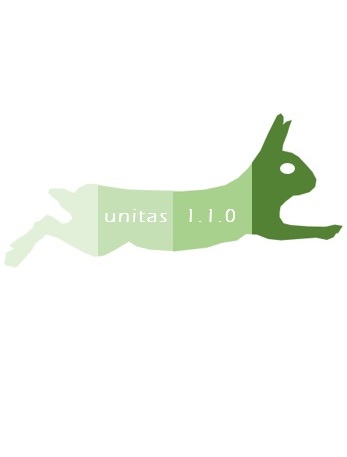 22/05/2017
22/05/2017unitas update (1.1.0) is out now. Minor bugs were removed and new functionality was included, e.g., the '-riborase' option for most sensitive detection of rRNA fragments using a complete set of rRNA reference sequences from NCBI nucleotide database.
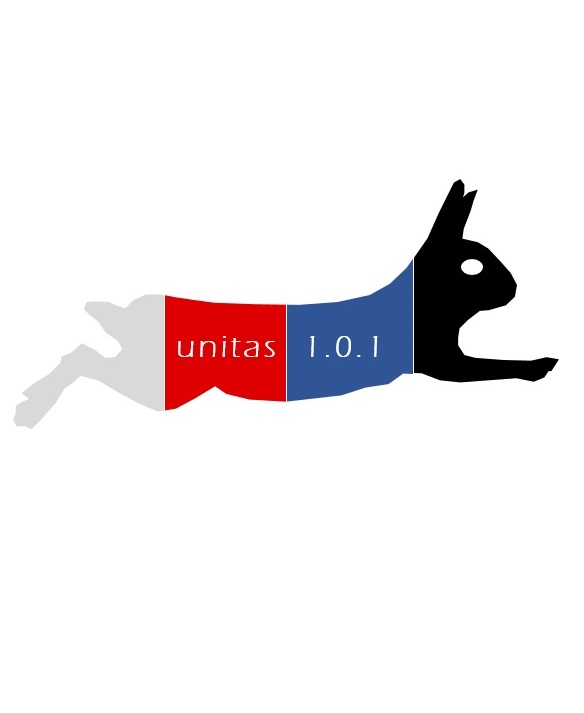 08/05/2017
08/05/2017First unitas update (1.0.1) is out now. With the new Ensembl release 88, Ensemble Genomes release 35 and SILVA rRNA database releas 128, the number of supported species grows to 835. The total available reference RNA data for small RNA annotation (synchronized on our server) comes up to more than 9 GB.
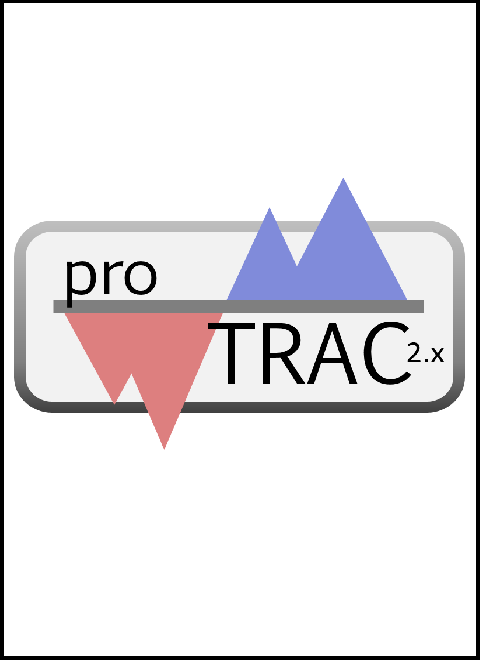 22/03/2017
22/03/2017proTRAC update (2.3.0) is out now. GD image files are disabled, which means that proTRAC no longer requires the GD module (installation of GD on some computers may be difficult for cryptic reasons). Input SAM files no longer need to be sorted and sequence data used to create SAM files must not be collapsed any longer.
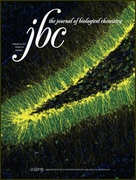 13/02/2017
13/02/2017New paper puplished in Journal of Biological Chemistry: Co-chaperone Hsp70/Hsp90 organizing protein (Hop) is Required for Transposon Silencing and piRNA Biogenesis. Karam and colleagues show that knockdown of Hop in the germ-line nurse cells (GLKD) of Drosophila ovaries leads to activation of transposons and increased DNA damage due to inefficient piRNA biogenesis.
 23/01/2017
23/01/2017In the course of a reorganization of working groups within the Biological Faculty, the former Institute of Anthropology is taken up in the newly formed Institute of Organismic and Molecular Evolutionary Biology.
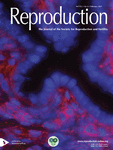 13/12/2016
13/12/2016New paper puplished in Reproduction: Bovine piRNA-like RNAs are associated with both mobile elements and mRNAs. Stewart J. Russell and coworkers show that piRNAs target both transposons and mRNAs in the early bovine embryo and that target-mRNA expression negatively correlates with piRNA expression, suggesting a role for piRNAs beyond transposon silencing in early embryogenesis.
 07/12/2016
07/12/2016The new proTRAC version (2.2.0) is out now. Finally, proTRAC accepts SAM files as input which means you can now use a more popular aligner such as Bowtie or STAR if you think sRNAmapper is to slow. BUT NOTE: SAM files must be sorted according to chromosome coordinates and FASTA/FASTQ files still must be collapsed! You should also make sure to allow multi-mapping.
For those who want to keep things easy, we still recommend to use sRNAmapper as it produces an appropriate map file when using the default settings.
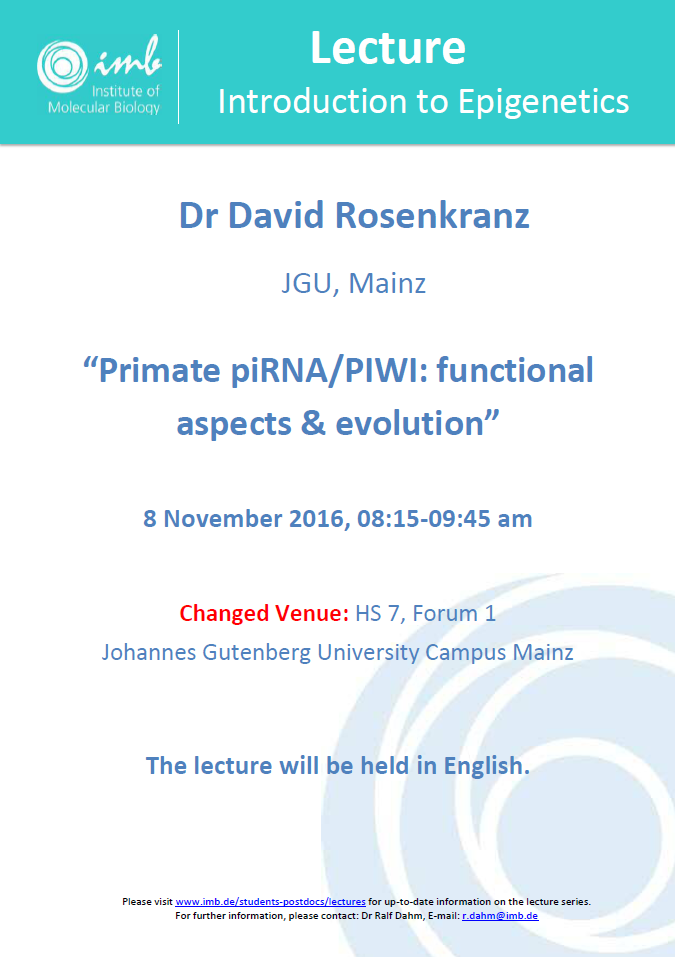 27/10/2016
27/10/2016Next lecture of the "Introduction to Epigenetics" series: Tuesday, 8 November 2016. The lecture will be held by David Rosenkranz: “Primate piRNA/PIWI: functional aspects and evolution” from 08:15-09:45 am. IMPORTANT: The lecture will be held in the lecture hall 7 (HS 7), Forum 1, JGU Campus. For further information please see the attached poster or visit the IMB homepage.
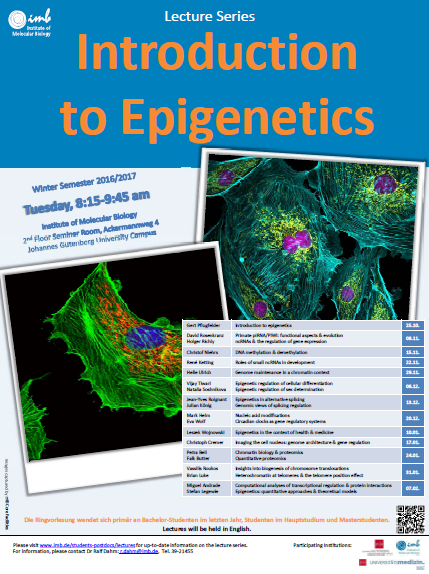 01/09/2016
01/09/2016The Lecture Series "Introduction to Epigenetics" starts on Tuesday, 25 October. The lecture series is open for everybody interested. The lecture 'Primate piRNA/PIWI: functional aspects and evolution' will be held on Tuesday, 8 November by David Rosenkranz from 8:15-9:00 a.m. You can download the Lecture Series schedule here.
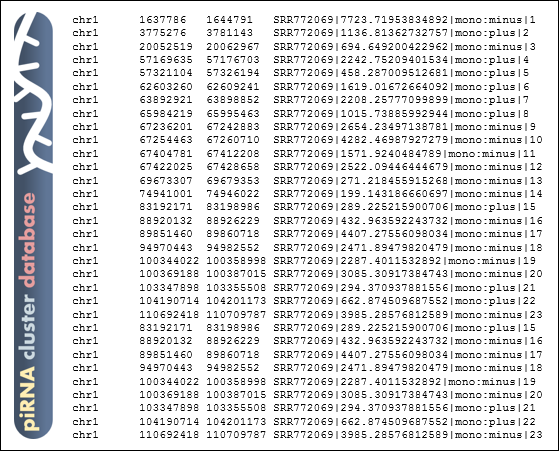 01/09/2016
01/09/2016We added BED files comprising clustered piRNAs and piRNA clusters for each SRA dataset to piRNA cluster database.
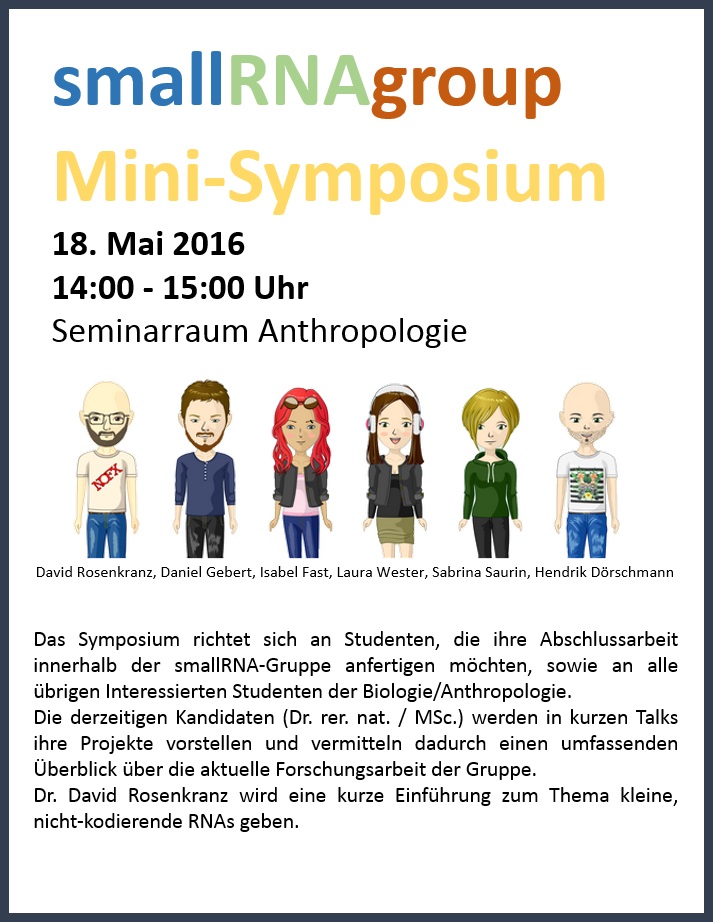 19/04/2016
19/04/2016Candidates of the small RNA group will present their research projects at the smallRNAgroup Mini-Symposium. The Symposium will be held on 18th May, 14:00-15:00 in the Institute of Anthropology, seminar room. The Symposium is aimed at master students that intend to do their master thesis in the group of David Rosenkranz, as well as all other interested Biology/Anthropology students.
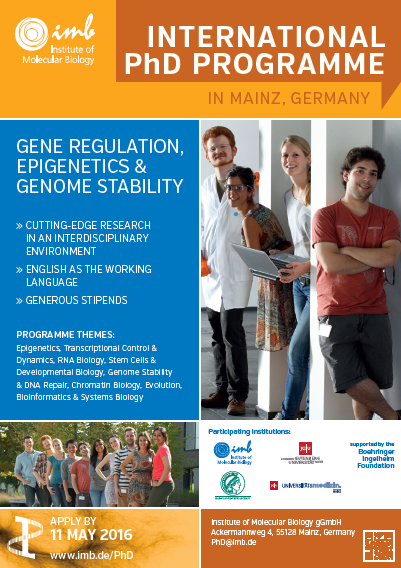 31/03/2016
31/03/2016small RNA group Mainz offers a project in the course of the International PhD programm 2016. Registration deadline is 01. May 2016. Application deadline is 08. May 2016. For more information on the IPP 2016 go to the IMB website.
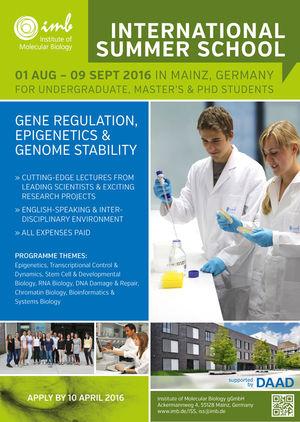 05/02/2016
05/02/2016Apply to the International Summer School programm and become part of the small RNA group Mainz. The application deadline is 10. April 2016. For more information on the ISS 2016 go to the IMB website.
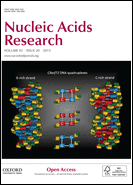 17/11/2015
17/11/2015piRNA cluster database paper is published in Nucleic Acids Research. piRNA cluster database: a web resource for piRNA producing loci.
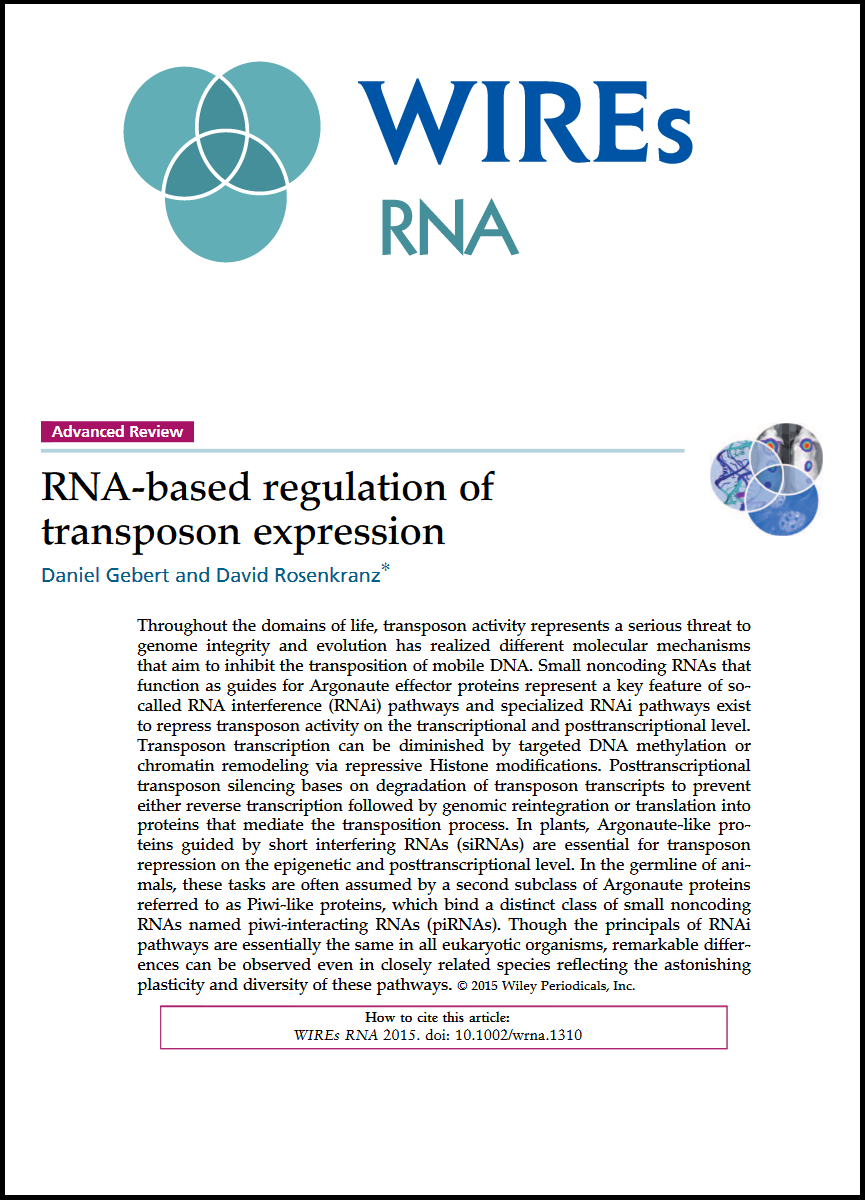 06/10/2015
06/10/2015A new review article is published in Wiley Interdisciplinary Reviews: RNA. RNA-based regulation of transposon expression.
 05/10/2015
05/10/2015proTRAC version 2.1 is now available for download at the software section. PNG image output files have been replaced by convenient HTML output files. The Transcription Factor Binding Site search function now includes sequences for three more testis expressed transcription factors (Gata4, SPZ1 and SOX9) involved in testis development and fertility.
 17/09/2015
17/09/2015piFETCH, a fetching tool for piRNA cluster database is available for download in the software section.
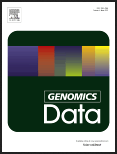 10/07/2015
10/07/2015'Data in Brief'-paper is available online at Genomics Data. The article provides detailed information on material and methods (applied to generate the according NCBI GEO datasets) for the Roovers et al. paper puplished in Cell Reports 2015.
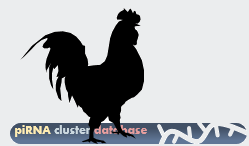 03/07/2015
03/07/2015Two SRA datasets from chicken were added to the piRNA cluster database. In line with data from fly and fish, and contrasting piRNAs in the mammalian adult male germline, piRNAs in chicken testis are enriched for transposon derived sequences compared to the whole genome situation.
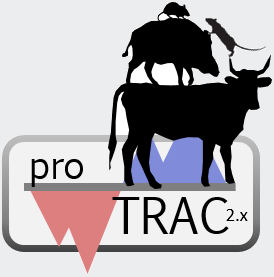 22/06/2015
22/06/2015Datasets from mouse, rat, cow, pig, zebrafish and fruitfly were added to the piRNA cluster database which now comprises more than 33,000 piRNA clusters from 11 species.
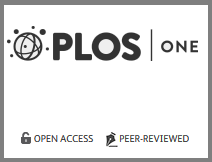 07/05/2015
07/05/2015New paper is out in PLoS ONE: piRNAs from Pig Testis Provide Evidence for a Conserved Role of the Piwi Pathway in Post-Transcriptional Gene Regulation in Mammals.
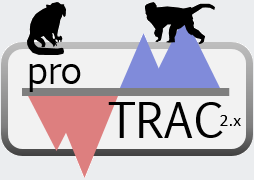 07/05/2015
07/05/2015Marmoset (Callithrix jacchus) and Rhesus monkey (Macaca mulatta) join the piRNA cluster database which now comprises 7558 piRNA clusters from 5 species. We also added heatmaps that refer to piRNA expression of different genomic loci accross different SRA datasets for each species.
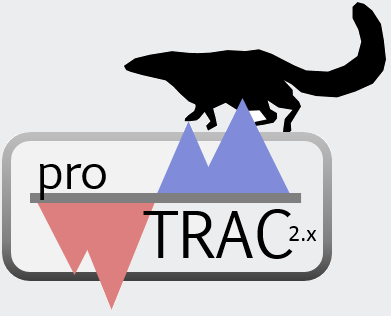 24/04/2015
24/04/2015Tree shrew (Tupaia belangeri) joins the piRNA cluster database with 139 piRNA clusters. With ~20% of transposon related sequences (total genome ~36%), piRNA clusters in tree shrew exhibit a very low amount of transposon sequences compared to other mammalian species studied thus far.
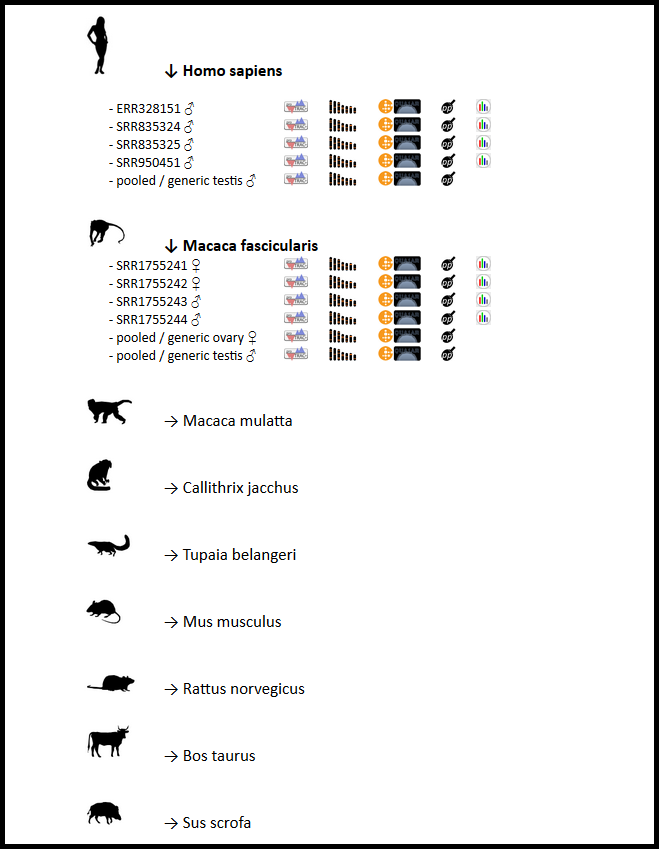 19/04/2015
19/04/2015Launch of piRNA cluster database, a comprehensive database for genomic piRNA clusters. We start with datasets from Homo sapiens and Macaca fascicularis. The database will be under construction until the first full release which is scheduled for the end of June 2015. During this time new datasets will be added bit by bit.
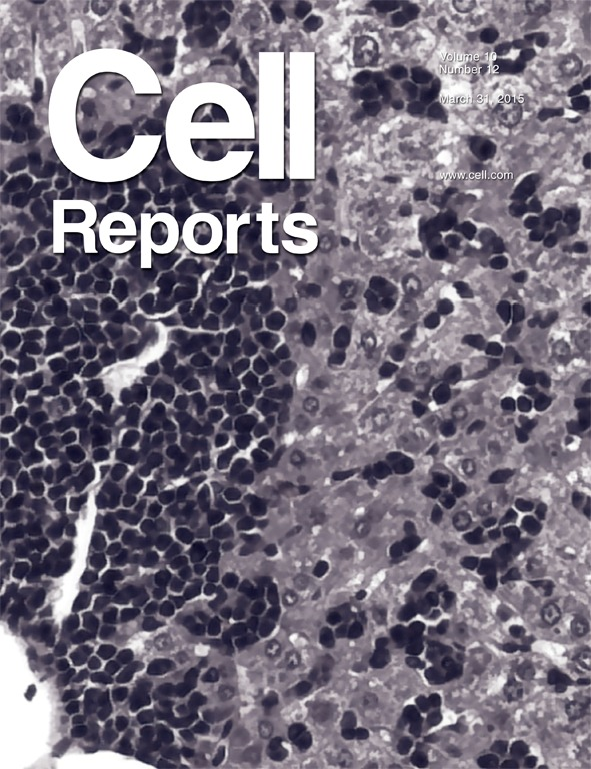 26/03/2015
26/03/2015New paper published in Cell Reports: Piwi proteins and piRNAs in mammalian oocytes and early embryos.
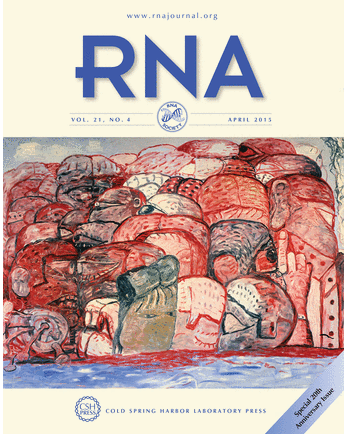 23/03/2015
23/03/2015New paper published in RNA: Tupaia small RNAs provide insights into function and evolution of RNAi-based transposon defense in mammals.
HOW TO FIND US ON THE CAMPUS







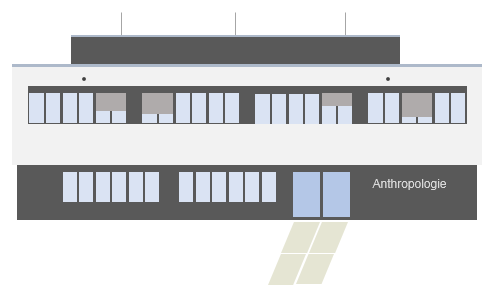
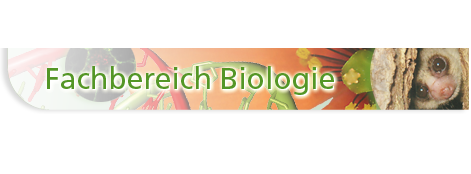

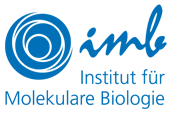




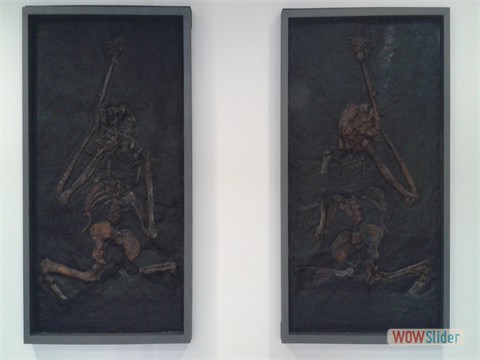


 2
2 1
1 3
3 4
4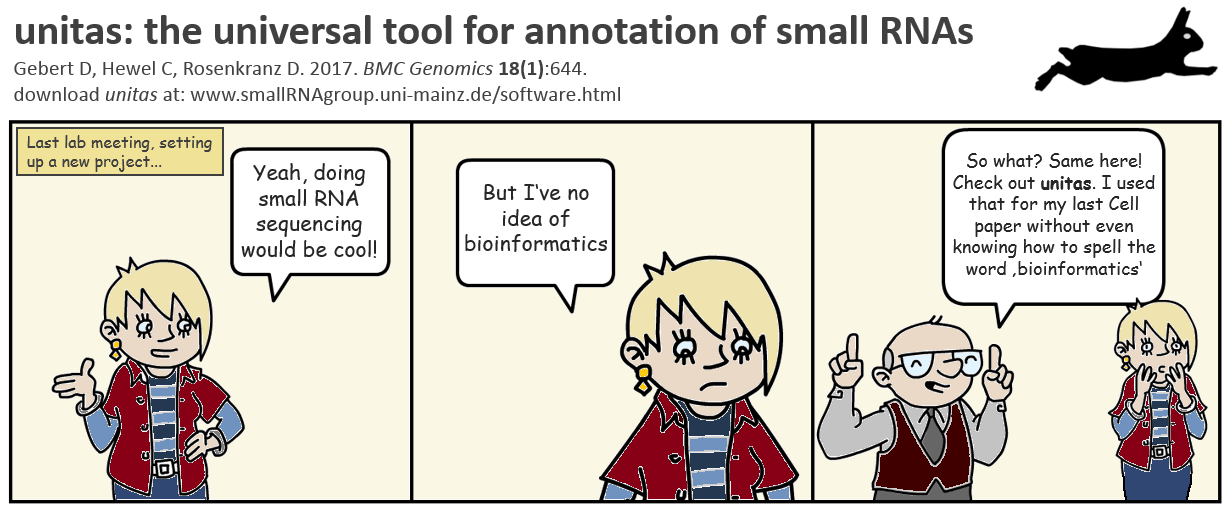
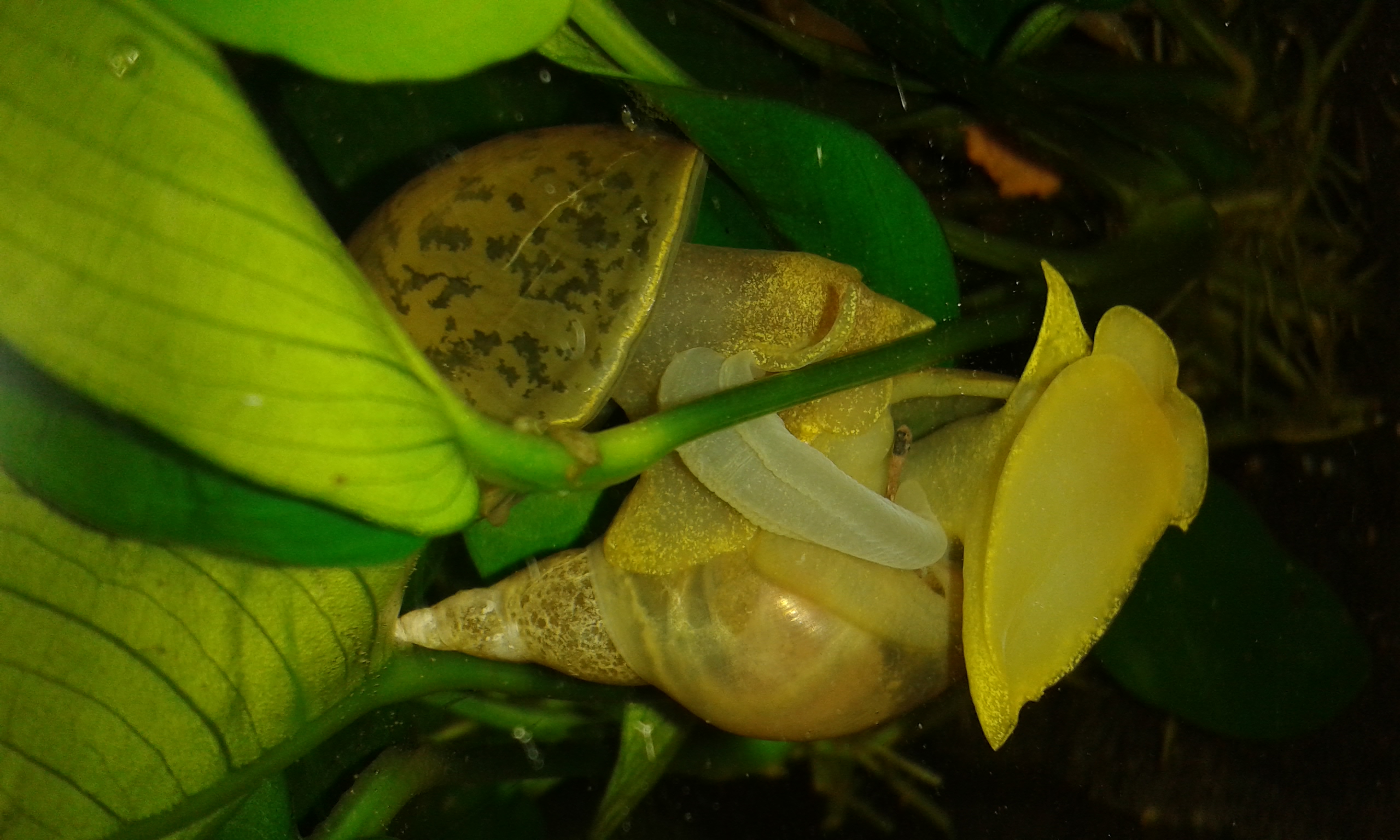
 07/12/2015
07/12/2015